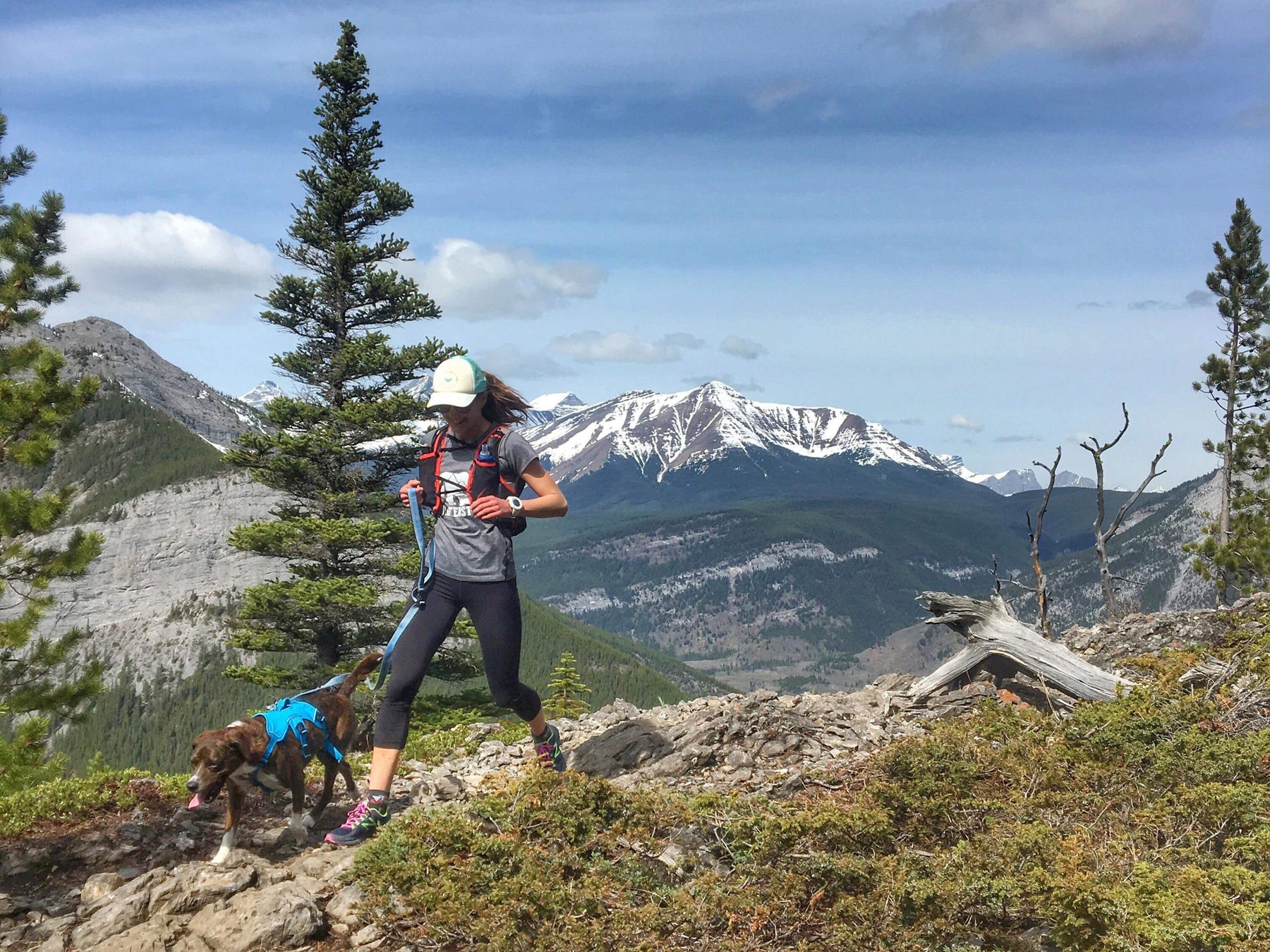
Tails on the Trails - Trail Running with your Dog
We are so fortunate in Canada to be able to share the National and Provincial parks with our dogs. As a trail runner, biker, hiker, skier and dog owner, I love being able to enjoy my favorite outdoor activities with my ever-enthusiastic adventure partner, Arnie. We are often on the trails with other dog owners, so I wanted to share with the trail community some of the frequently asked questions I get asked as a veterinarian about ‘trail dogs’.
By Bronwyn Fullagar (BVSc, MS, DACVS-SA). She is a small animal Veterinary Surgeon.
Tails on the Trails
How do I know if my dog will make a good ‘trail dog’?
All kinds of dogs can enjoy the outdoors with their owners, but it is important to understand the limitations of your particular canine friend. Just like not all people can safely partake in a 20km trail run or an all day alpine scramble, not all dogs are suited to the rigors of the running, biking or hiking that we ask of them. Importantly, unlike most humans, dogs are unaware of their own limitations (this is also what makes them such amazing training partners) and will exert themselves to the point of serious injury, or even death, if highly motivated by us. In addition, dogs are poor planners when it comes to nutrition and hydration, so it is our responsibility as their owners and trail companions to ensure they stay healthy on the trail. Dogs who are of very young or very old age, toy or giant breeds, brachycephalic breeds (e.g. bulldogs, pugs, Boston terriers), and dogs with cardiovascular or neuromuscular conditions may not be suited to strenuous trail exercise. We will discuss the characteristics of the ideal trail dog and how to enjoy the trails with any dog on Wednesday night.
What is heat stroke and how can my dog be affected?
Heat stroke is defined in both human and veterinary medicine as “A form of hyperthermia (core body temperature >40oC) associated with a systemic inflammatory response leading to a syndrome of multi-organ dysfunction in which encephalopathy predominates”. Hyperthermia (elevated body temperature) leads to a continuum of heat-related illness, ranging from heat stress (increased strain on the body, discomfort) through to heat exhaustion (weakness, anxiety, fainting) and finally true heat stroke which is when the body’s adaptive mechanisms have been overwhelmed and key organ systems begin to fail. Heat stroke is 50% fatal in dogs. It can be either exertional (secondary to strenuous exercise) or nonexertional(due to exposure to hot environments, like a hot car). When out on the trails with your dog, exertional heat stroke is your biggest concern, so it is important to understand the early signs of heat stress and to intervene before irreversible illness occurs.

Any dog can be affected by heat stroke, but dogs who are of older age, are overweight or obese, have a thick or dark coloured hair coat, have cardiovascular disease, neuromuscular disease or upper airway abnormalities (e.g. laryngeal paralysis, brachycephalic breeds) are most at risk. Acclimatization is also very important – it takes about 60 days for the body to fully acclimatize to an increase in ambient temperature. In the Bow Valley, where the temperature can change suddenly during spring from close to freezing to >20oC, dogs have little opportunity to acclimatize and early in the season is when we see most dogs affected with heat stroke, even though the weather may not seem ‘hot’. If you are unsure of your dog’s individual risk of heat stroke or their suitability for strenuous trail exercise, it is best to consult your family veterinarian for advice.
If you are out on the trail and your dog seems to be lagging behind, is very tired, wants to lie down, is making ‘snoring’ noises while panting or seems off balance or agitated, stop exercising immediately, provide water, shade and wet your dog’s fur, then head home and call your local veterinarian for advice. If these signs worsen despite your initial actions, if your dog is having trouble breathing, collapses, has brick red, blue or very pale gums, cannot walk or is not responding normally to you, seek veterinary attention immediately.
How can I prevent heat stroke and keep my dog cool on the trails?
- Allow an acclimatization period. Start summer trail activities gradually and build up the duration and intensity over the first month of spring/summer.
- Encourage your dog to drink. Dogs will not generally drink enough water voluntarily while they are exercising so it is important for us to have some strategies to encourage adequate hydration. These can include carrying water and a bowl for your dog or teaching him/her to drink from a squeeze bottle, carrying electrolyte solution (e.g. ‘Hydralyte’ - dogs will often drink this more readily than water), stopping at streams or rivers to allow access to fresh flowing water. Just like in people, eating snow is a less effective means of hydration than drinking water or electrolytes.
- Wet your dog’s fur, especially on sparsely-haired regions, to allow evaporative cooling from a larger surface area. Having your dog stand in a creek or stand/lie in a patch of snow is a good way to do this.
- Use a cooling vest such as the ‘Jet Stream’ or ‘Swamp Cooler’ cooling vests from Ruffwear – these are designed to stay wet and provide both evaporative cooling and conduction through contact with a cool surface.
- Clip or shave your dog if he/she has a very long, thick or dark coloured coat. This may be less practical in the Bow Valley where dogs need their thick coats in winter but is certainly widely used in warmer parts of the world.
- Exercise during cooler parts of the day, in the shade and rest often.
- Does my dog need to wear booties?
How do I protect my dog’s paws?
We all know how much dogs love wearing booties! A common early-season injury in trail dogs is abrasions to their paw pads. This is usually the result of strenuous or prolonged exercise on rough or rocky terrain, at the start of the summer season and is intensified if the ground is hot. Most dogs are kept indoors or on soft ground throughout the winter and then start exercising on rough terrain once the snow melts. The best way to prevent paw pad injuries is to acclimatize your dog by starting trail exercise gradually and building up. Walking and hiking below treeline cause less damage to the paw pads than scrambling, trail running and mountain biking. By checking your dog’s feet throughout the day, small abrasions can be detected early and by slowing down or returning home more serious abrasions can be avoided. Booties can help to prevent injury on very rough terrain (e.g. scree) and protect paws that have been injured, but prevent tactile feedback and limit a dog’s traction. In general, dogs with normal paws that are well acclimatized to the trails do not need booties in the summer.
See you on Wednesday, 27 June at 6:30pm at SkiUphill-RunUphill in Canmore!
We’ll talk more about trail dogs, heat stroke, injuries, trail safety, gear to bring on the trail, dog first aid and there will be giveaways from the dog outdoor brand, Ruffwear. There will be plenty of time for questions, see you there!





